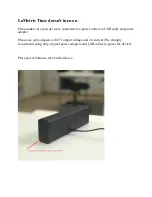
3
4. SMOKING INTRODUCTION
Smoking food is an art form. There is much to learn about the different processes and equipment
available today. Cold smoking and hot smoking are two different ways to smoke food and there
really isn’t one singular cooking or smoking device that does both.
4.1 Cold Smoking
Cold smoking takes place at temperatures around 20°C or lower and involves smoking partially
cured foods with very little heat. This is a popular smoking method for foods such as nuts, fish,
jerky and foods that are dried or cured prior to smoking. It is important to remember that cold
smoking is not a cooking process and that cold smoked foods are not actually ‘cooked’. Instead
they are cured and preserved. This can allow foods to be edible for hours, days, weeks or months
after smoking. It is always advisable to employ safe food practices when cold smoking and ensure
that you follow recipe instructions very carefully.
Your Hark gas smoker is not ideally suited to cold smoking.
4.2 Hot Smoking
Hot smoking involves cooking at low temperatures over long periods of time (anywhere from
7-24 hours). Hot smoking takes place when cooking food with temperatures greater than what is
considered to be normal ambient temperatures.
Typically, hot smoking is carried out in temperatures between 70-180˚C. It is important to note that
hot smoking alone does not act to preserve food. Anything hot smoked should generally be stored
in a refrigerator.
Electric and gas smokers tend to burn the source of smoke ie wood chips or pellets, from the
outset. They fill the chamber with high density smoke and heat the food within this smoke-heavy
cooking chamber. This is what we mean by hot smoking. The process works well and produces
more of a ‘smoked’ taste than a barbequed one. Think smoked chicken vs barbequed chicken,
there’s a subtle difference.
Your Hark gas smoker is suited to hot smoking.
Low and Slow
US style barbequing with meats such as pork shoulder (pulled pork), ribs and briskets
are examples of hot smoking. These classic smoked BBQ meats are generally smoked at
temperatures between 110-120˚C and will soften greatly and increase in flavour if you hold them
‘at temperature’ for several hours inside the cooking chamber.
Temperature control is essential to smoking successfully. Practice keeping your smoker at a stable
temperature in the smoking “zone” for hours at a time. Don’t be tempted to open the smoker
door, as this lets out heat and air in and may take some 15 minutes or more to regain the original
temperature.
4.3 Smoke Quantity & Quality
Too much smoke or the wrong type of smoke will make food bitter. The bitter taste is attributed to
creosote produced from ‘white smoke’, or, from the soot deposited from ‘black smoke’. Good hot
smoking means clean smoke travels over food continuously from the wood chip box and into the
cooking chamber, picking up faint smoke on the way.







































